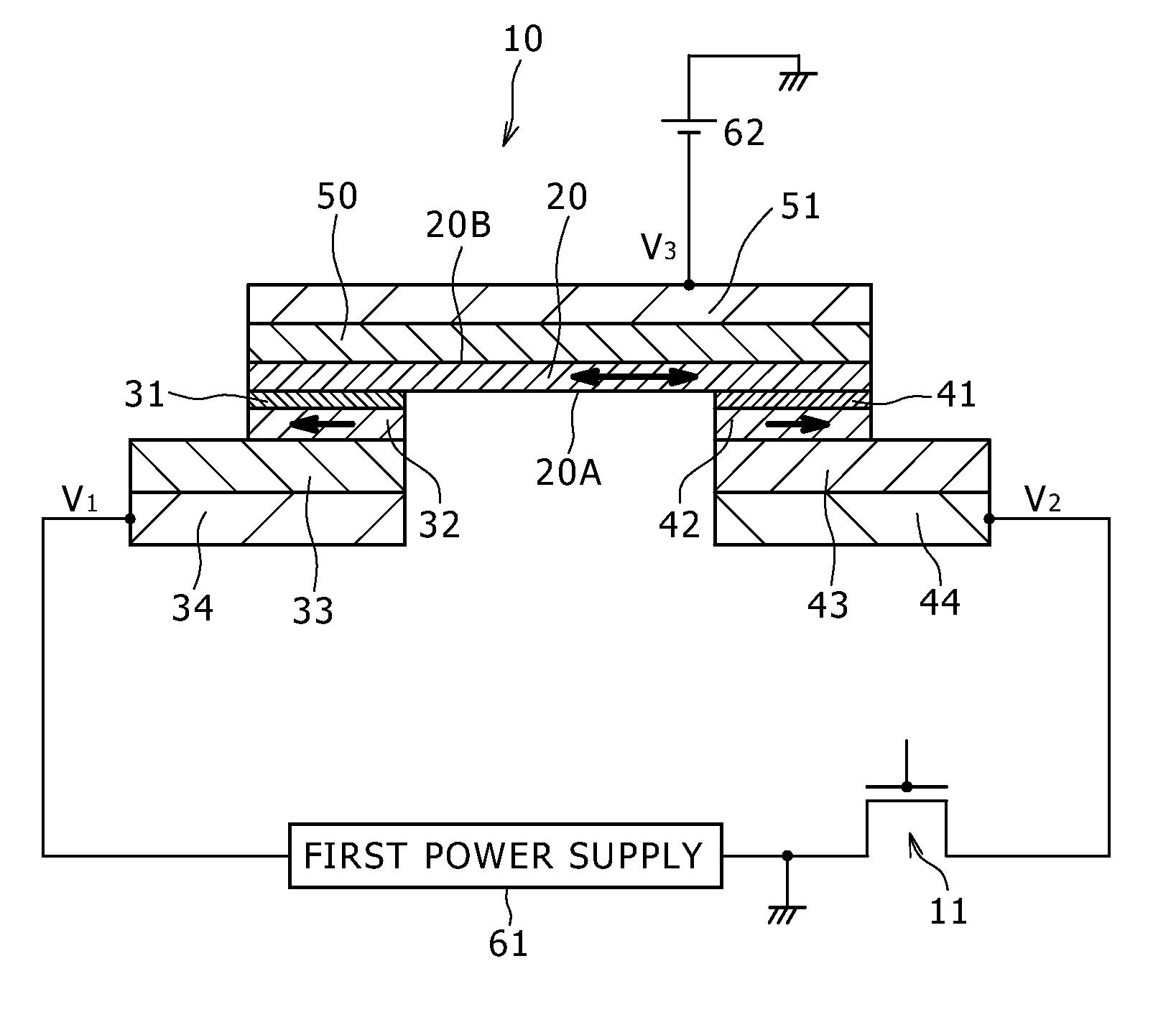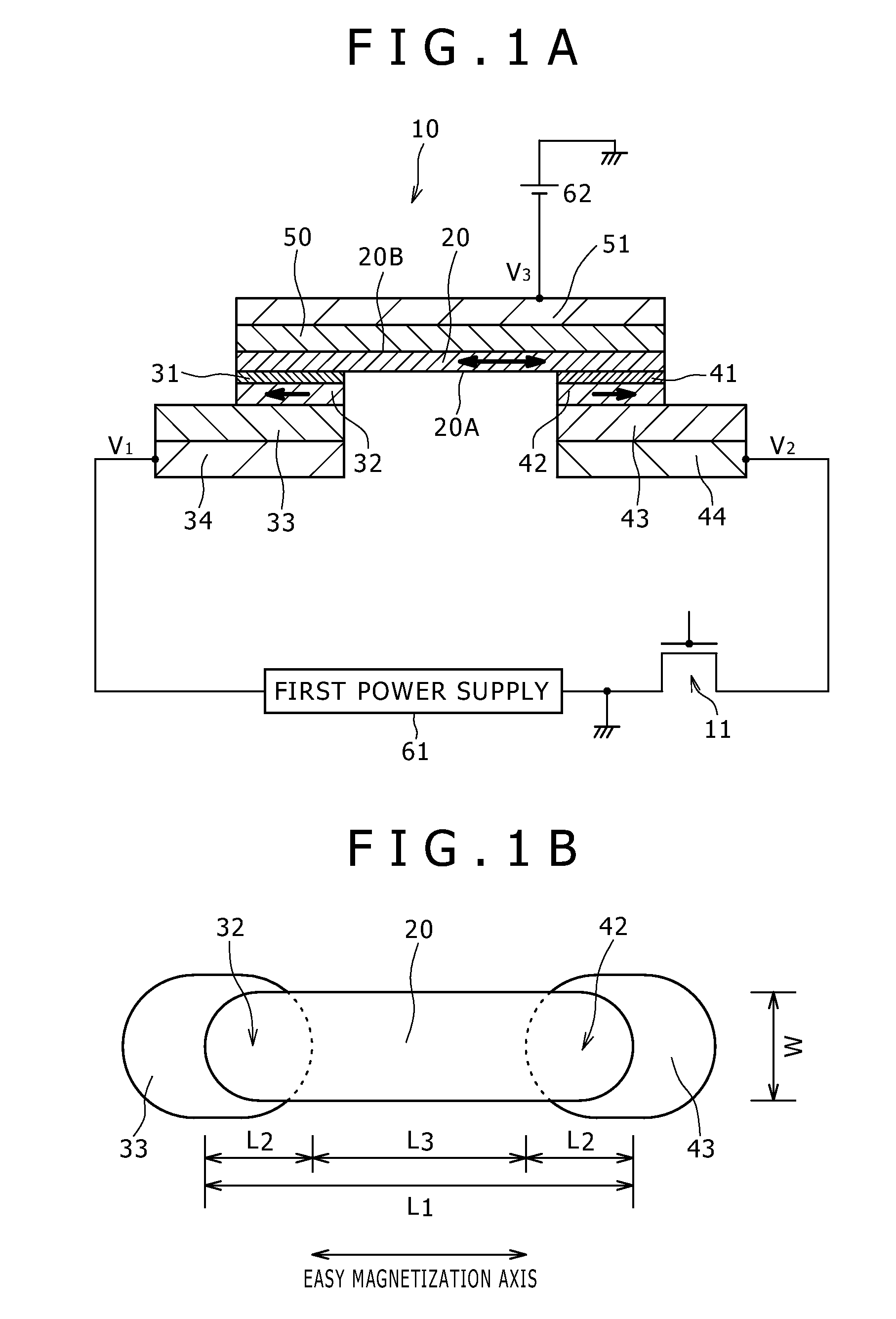Spin-injection magnetoresistance effect element
a technology of magnetoresistance and effect element, which is applied in the manufacture of flux-sensitive heads, instruments, record information storage, etc., can solve the problems of increasing the reversal time period, lowering the thermal fluctuation resistance, and complicated multi-layer structure of magnetic elements, and achieves high capacity, high speed, and low power consumption.
- Summary
- Abstract
- Description
- Claims
- Application Information
AI Technical Summary
Benefits of technology
Problems solved by technology
Method used
Image
Examples
first embodiment
[0046] A first embodiment of the present invention relates to a spin-injection magnetoresistance effect element, and more specifically to a spin-injection magnetoresistance effect element applied to MRAM. A spin-injection magnetoresistance effect element 10 according to the first embodiment has a three-terminal spin transfer element structure that is referred to also as a voltage-assisted spin-injection magnetization reversal structure. FIG. 1A is a conceptual diagram illustrating the element 10. FIG. 1B is a schematic diagram illustrating the arrangement of a magnetization reversal layer, a first magnetization reference layer and a second magnetization reference layer in the element 10. FIG. 2 illustrates an equivalent circuit of the MRAM. FIG. 3 is a schematic sectional view illustrating part of the MRAM. Turning now to FIG. 1A, the spin-injection magnetoresistance effect element 10 includes (A) a magnetization reversal layer (referred to also as a free layer) 20 that has a first ...
second embodiment
[0073] The second embodiment is obtained by modifying part of the first embodiment. A spin-injection magnetoresistance effect element of the second embodiment is different from an element of the first embodiment in that in the second embodiment, a synthetic ferri-magnetic structure is employed for either one of the first and second magnetization reference layers. In the following description, a first magnetization reference layer 132 has a synthetic ferri-magnetic structure. FIG. 6A is a conceptual diagram illustrating part of a spin-injection magnetoresistance effect element of the second embodiment. FIG. 6B is an enlarged conceptual diagram illustrating the first magnetization reference layer 132 and other layers in the spin-injection magnetoresistance effect element of the second embodiment. It should be noted that a structure in which the second magnetization reference layer 42 has a synthetic ferri-magnetic structure is also available.
[0074] In the second embodiment, the first...
third embodiment
[0083] The third embodiment is also obtained by modifying part of the first embodiment. A spin-injection magnetoresistance effect element of the third embodiment is different from an element of the first embodiment in that in the third embodiment, first and second magnetization reference layers 32 and 42 have sufficiently high magnetic anisotropy energy (Ku·V), and therefore the first and second antiferromagnetic layers 33 and 43 are absent. FIG. 8A is a conceptual diagram illustrating a spin-injection magnetoresistance effect element according to the third embodiment.
[0084] The expression that the magnetic anisotropy energy (Ku·V) is “sufficiently high” means the following states:
[0085] (1) The magnetization directions of the first and second magnetization reference layers 32 and 42 overlapping with the magnetization reversal layer 20 can be parallel to the easy magnetization axis of the magnetization reversal layer 20. That is, the magnetization reference layers 32 and 42 mainta...
PUM
 Login to View More
Login to View More Abstract
Description
Claims
Application Information
 Login to View More
Login to View More - R&D
- Intellectual Property
- Life Sciences
- Materials
- Tech Scout
- Unparalleled Data Quality
- Higher Quality Content
- 60% Fewer Hallucinations
Browse by: Latest US Patents, China's latest patents, Technical Efficacy Thesaurus, Application Domain, Technology Topic, Popular Technical Reports.
© 2025 PatSnap. All rights reserved.Legal|Privacy policy|Modern Slavery Act Transparency Statement|Sitemap|About US| Contact US: help@patsnap.com



